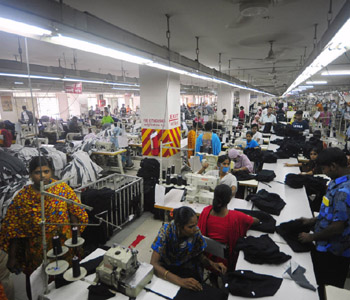(Photo Credit: Munir Uz Zaman / AFP)
By Philip Hamilton
(BGF) – Recently, the Boston Global Forum was fortunate enough to interview Mark Robertson, the Head of Communications at Sedex Global. Sedex Global is a non-profit organization that works to enhance global supply chain transparency through audit information-sharing and collaboration between buyers and sellers. Following the recent tragedies in Bangladesh, supply chain issues, particularly in the context of worker safety and rights in the Ready Made Garment sector, have re-emerged at the forefront of international consciousness.
In response to the increased international scrutiny of safety issues in the garment sector, auditing of supply chains has become a widely recognized and publicized solution to concerns that governments, and major brands and retailers are sourcing from suppliers who operate in unsafe conditions. This concern has proven to be all too real for the United States Marine Corp and Walmart, who allegedly purchased goods from suppliers who utilized Tazreen Fashions Factory and Rana Plaza, respectively. Without absolving the major retailers, brands, governments, and others who source from suppliers who operate in questionable working conditions, a major issue is the increasingly complex web of global supply chains.
As Robertson noted, the scale and complexity of global supply chains presents a key issue for many companies: “Some of our members have as many as 20-30,000 suppliers globally, indirectly employing hundreds of thousands of people. So how do you put together a supply chain program that’s going to deal with that scale and complexity? So I think scale and complexity can be things that companies don’t necessarily know how to deal with and that’s often the starting point for Sedex’s work with them.” That level of complexity in global supply chains creates a scenario in which unauthorized sub-contracting can creep into a company’s supply chain, a well-known issues in Ready Made Garment sector.
Moreover, increased international scrutiny regarding supply chain sustainability has led to an emphasis on understanding the totality of a company’s impacts on worker safety and rights, whether those impacts are direct or indirect. Robertson noted that traditionally, companies might only assess their direct impacts as part of their corporate social responsibility programs. However, the more complex the supply chain, the more complex the impacts a company may have. Thus, a deeper understanding of a company’s global supply chain can further elucidate the impacts a company is having on worker safety and rights.
As a result, it is vital that companies, retailers, and brands map their supply chain and look as deeply as possible into who their suppliers are and who their suppliers work with. Complex global supply chains consist of multiple tiers of suppliers. The first tier supplier is likely to be in direct contact with the buyer (company, brand, retailer). Furthermore, that first tier retailer, as Robertson noted, may simply be an agent who then contracts that work out to other suppliers. When this is done transparently and the buyer is made aware of this arrangement then this does not present much of a difficulty, although it makes the supply chain increasingly complex. However, companies often do not look much further than their first tier supplier and are thus unaware of the work and safety conditions further down their supply chain.
Relatedly, Sedex’s research has shown that risks increase further down the supply chain, most likely because “…often the suppliers are smaller, they don’t necessarily have the tools, the resources, or the knowledge even to tackle these issues or they’re nearer to the risks.” Thus, by linking members who are buyers and members who are suppliers Sedex allows for collaboration, information-sharing, and transparency thereby illuminating supply chain risks across multiple tiers.
Given all of above, are audits the answer to improving worker safety and rights? Yes and no. According Robertson audits are “…play a vital role in highlighting where the risks are and identifying actions that need to be addressed. But it’s also important that companies look beyond simple compliance models and work toward best practice.” Thus, audits can play a significant role in illuminating risks in supply-chains and allowing brands and retailers to be “…more proactive and less reactive” in preventing future tragedies. However, audits alone are unlikely to be enough. Therefore, according to Robertson, it is important to couple capacity-building programs with the audit process.
Going forward, Robertson warns that we must not focus exclusively on the issues in Bangladesh, to the exclusion of issues occurring elsewhere. Certainly, the focus on Bangladesh is important, but it is not the only country hosting complex global supply chains. Furthermore, Robertson emphasizes that continued collaboration is necessary: “What about the risks that exist in other garment producing countries such as India, China, Pakistan, Turkey or Vietnam? We don’t need 50 new initiatives to tackle these issues, we need to see more people working together around them.” With the one year anniversary of the Rana Plaza collapse looming on the horizon, it remains to be seen whether the world can come together to prevent future tragedies in the complex global supply chains we all rely on.
